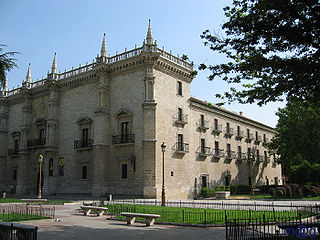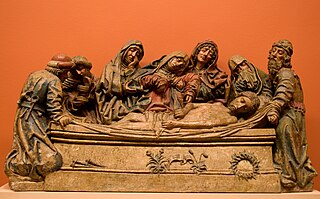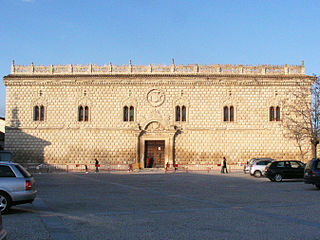
Segovia is a city in the autonomous community of Castile and León, Spain. It is the capital and most populated municipality of the Province of Segovia. Segovia is in the Inner Plateau, near the northern slopes of the Sistema Central range and on a bend of the Eresma river.

Segovia is a province of central/northern Spain, in the southern part of the autonomous community of Castile and León. It is bordered by the province of Burgos in the north, Soria in the northeast, Guadalajara in the east, Madrid in the south, Ávila in the west and southwest, and Valladolid in the northwest. The average temperature ranges from 10 °C to 20 °C.

An alcázar, from Arabic al-Qasr, is a type of Islamic castle or palace in Spain built during Muslim rule between the 8th and 15th centuries. They functioned as homes and regional capitals for governmental figures throughout the Umayyad caliphate and later for Christian rulers following the Iberian Reconquista. The term alcázar is also used for many medieval castles built by Christians on earlier Roman, Visigothic or Islamic fortifications and is frequently used as a synonym for castillo or castle. In Latin America there are also several colonial palaces called alcázars.

The Royal Sites are a set of palaces, monasteries, and convents built for and under the patronage of the Spanish monarchy. They are administered by Patrimonio Nacional (National Heritage), a Spanish state agency; most are open to the public, at least in part, except when they are needed for state or official events.

Mudéjar art, or Mudéjar style, was a type of ornamentation and decoration used in the Iberian Christian kingdoms, primarily between the 13th and 16th centuries. It was applied to Romanesque, Gothic and Renaissance architectural styles as constructive, ornamental and decorative motifs derived from those that had been brought to or developed in Al-Andalus. These motifs and techniques were also present in the art and crafts, especially Hispano-Moresque lustreware that was once widely exported across Europe from southern and eastern Spain at the time.

Old Castile is a historic region of Spain, which had different definitions along the centuries. Its extension was formally defined in the 1833 territorial division of Spain as the sum of the following provinces: Santander, Burgos, Logroño, Soria, Segovia, Ávila, Valladolid and Palencia. As the rest of regions in that division, Old Castile never had any special administrative agency; only the individual provinces had their own management.

The Cathedral of Saint Mary of the See, better known as Seville Cathedral, is a Catholic cathedral and former mosque in Seville, Andalusia, Spain. It was registered in 1987 by UNESCO as a World Heritage Site, along with the adjoining Alcázar palace complex and the General Archive of the Indies. It is one of the largest churches in the world as well as the largest Gothic church.

Úbeda is a municipality of Spain located in the province of Jaén, Andalusia.

The University of Valladolid is a public university located in the city of Valladolid, Valladolid province, autonomous region of Castile and Leon, Spain. Established in the 13th century, it is one of the oldest universities in the world. The university has 26,000 undergraduate students and more than 2,300 professors.

Cuéllar is a municipality in the Province of Segovia, within the autonomous community of Castile and León, Spain.

Churrigueresque, also but less commonly "Ultra Baroque", refers to a Spanish Baroque style of elaborate sculptural architectural ornament which emerged as a manner of stucco decoration in Spain in the late 17th century and was used until about 1750, marked by extreme, expressive and florid decorative detailing, normally found above the entrance on the main façade of a building.

The Palacio de Santa Cruz is an Early-Renaissance palace in Valladolid, in Castile and León, Spain. Construction began in 1486 but in 1490 building came under the control of Lorenzo Vázquez de Segovia who finally completed it in 1491.

Spanish Renaissance architecture was that style of Renaissance architecture in the last decades of the 15th century. Renaissance evolved firstly in Florence and then Rome and other parts of the Italian Peninsula as the result of Renaissance humanism and a revived interest in Classical architecture. In Spain, the Renaissance began to be grafted to Gothic forms as mathematicians and engineers rediscovered building as one of the technological sciences. In the time of King Felipe II (1556–1589), the Renaissance influence expanded throughout the territory thanks to the dissemination of architectural treatises.

The Alcazar of Segovia is a medieval castle located in the city of Segovia, in Castile and León, Spain. It has existed since at least the 12th century, and is one of the most renowned medieval castles globally and one of the most visited landmarks in Spain. It has been the backdrop for significant historical events and has been home to twenty-two kings, along with notable historical figures.

IE University, known as IE Universidad or Universidad Instituto de Empresa, is a private university with campuses in Madrid, Community of Madrid and Segovia, Castile and León, (Spain) that formed as an outgrowth of IE Business School originally founded as the Instituto de Empresa (IE). IE University's programs are run in English and Spanish, and are compliant with the terms of the European Higher Education Area.

The Sevillian school of sculpture—the tradition of Christian religious sculpture in Seville, Andalusia, Spain—began in the 13th century, formed a clear tradition of its own in the 16th century, and continues into the present. The sculptures are generally worked in wood in a technique known as encarnación.

La Blanca is a Maya pre-Columbian Mesoamerican archaeological site in the municipality of Melchor de Mencos in the northern Petén Department of Guatemala. It has an occupation dating predominantly from the Middle Preclassic period of Mesoamerican chronology. This site belongs to the later period of the Mokaya culture. The site is located in the lower reaches of the Mopan River valley and features a large acropolis complex. Activity at the site has been dated as far back as the Early Classic, with principal occupation of the site occurring in the Late Classic period, although some level of occupation continued into the Early Postclassic.

The commonly called Palace of the Dukes of Medinaceli is a Renaissance palace located in Cogolludo, Spain, and is one of the most ancient sites of the region.

Rodrigo Díaz de Vivar y Mendoza, was a Spanish noble of the House of Mendoza. He was the firstborn son of the powerful Cardinal Pedro González de Mendoza and went on to become the 1st Conde del Cid and the 1st Marquis of Cenete, a title he held from 1491 until his death.

The Walls of Madrid are the five successive sets of walls that surrounded the city of Madrid from the Middle Ages until the end of the 19th century. Some of the walls had a defensive or military function, while others made it easy to tax goods entering the city. Towards the end of the 19th century the demographic explosion that came with the Industrial Revolution prompted urban expansion throughout Spain. Older walls were torn down to enable the expansion of the city under the grid plan of Carlos María de Castro.




















